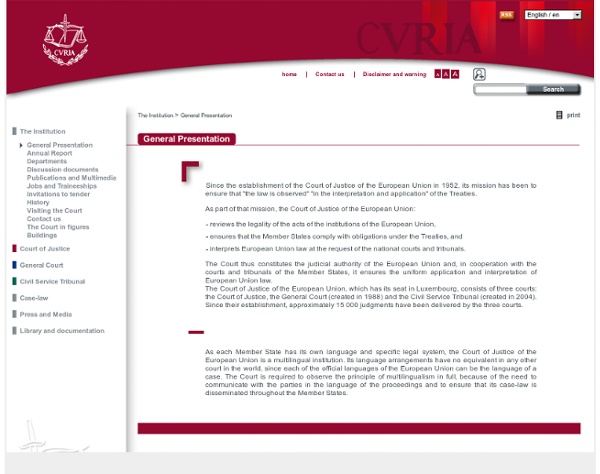Cour de justice européenne
Since the establishment of the Court of Justice of the European Union in 1952, its mission has been to ensure that "the law is observed" "in the interpretation and application" of the Treaties. As part of that mission, the Court of Justice of the European Union: reviews the legality of the acts of the institutions of the European Union, ensures that the Member States comply with obligations under the Treaties, and interprets European Union law at the request of the national courts and tribunals. The Court thus constitutes the judicial authority of the European Union and, in cooperation with the courts and tribunals of the Member States, it ensures the uniform application and interpretation of European Union law.The Court of Justice of the European Union, which has its seat in Luxembourg, consists of three courts: the Court of Justice, the General Court (created in 1988) and the Civil Service Tribunal (created in 2004).
Cyberdroit - Le droit à l'épreuve de l'Internet
La LCEN a enfin son décret sur les données à conserver par les hébergeurs
Sept ans après la promulgation de la loi du 21 juin 2004 sur la confiance pour la confiance dans l'économie numérique (LCEN), le décret relatif à la conservation des données "permettant d'identifier toute personne ayant contribué à la création d'un contenu mis en ligne" est enfin paru ce mardi au Journal Officiel. Il précise que devront être conservés pendant un an par les hébergeurs à compter de la création, de la modification ou de la suppression d'un contenu : L'identifiant de la connexion à l'origine de la communication ; L'identifiant attribué par le système d'information au contenu, objet de l'opération ; Les types de protocoles utilisés pour la connexion au service et pour le transfert des contenus ; La nature de l'opération ; Les date et heure de l'opération ; L'identifiant utilisé par l'auteur de l'opération lorsque celui-ci l'a fourni ; Beaucoup plus sensible.
L'usurpation d'identité en questions
Si cette fonctionnalité n’est pas encore disponible auprès des 26 millions d’utilisateurs français (Chiffres officiels de Facebook datant du mois d’aout 2013), la CNIL vous informe des principaux changements en matière de vie privée et des conséquences éventuelles sur les comptes des utilisateurs de Facebook. Menez le test pour savoir si votre profil est concerné Si vous souhaitez savoir si ce nouvel outil met en avant des informations que vous ne voulez pas voir apparaitre, rendez vous sur votre profil Facebook. Cliquez sur l’onglet , puis « compte » et enfin, sélectionnez la langue « English US ». Il ne vous reste plus qu’à effectuer des requêtes type pour savoir quelles informations peuvent être remontées par cet outil de recherche. Méthodologie : un test à réaliser en binôme Vous souhaitez davantage sécuriser votre compte ? Prochainement, la CNIL va publier un tutoriel vidéo pour vous aider à maitriser l’utilisation des paramètres de Facebook. La position de la CNIL
Related:
Related:



